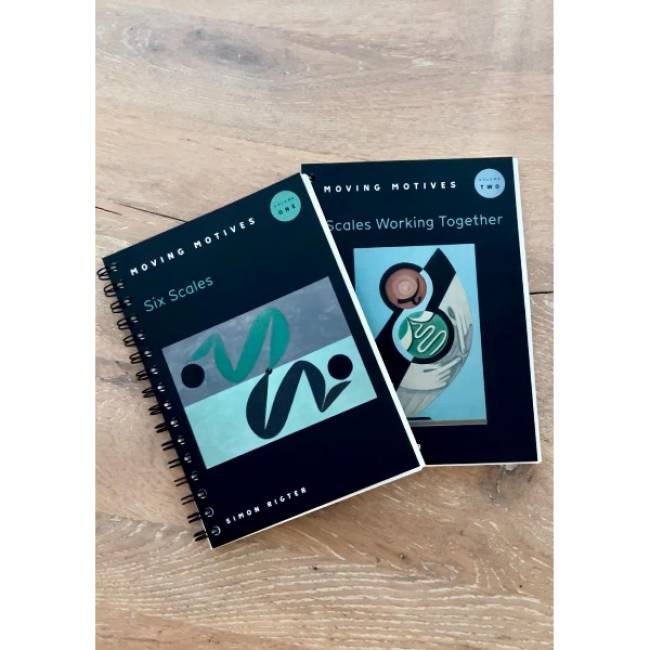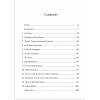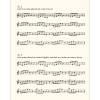Simon Rigter: Moving Motives vol. 1 & 2
The primary objectives of this method book include ear training, development of insight and understanding, flexibility in all keys, and achieving a feel for how different scales work together. Meer informatie...
This contains of volume 1 & 2 (click here for volume 1 and volume 2 seperately)
Moving Motives:
During my first conservatory lesson, my teacher told me to learn the major and minor scales in thirds, triads and seventh chords in all twelve keys. He taught me that anything that goes up can come back down, anything in major can be played in minor, and that any motive can be moved through the degrees of a scale.
That was in September 1989, and I'm still practising variations of things I learnt in that lesson as I write this in May 2024.
Moving Motives is not about improvisation, but the exercises serve as preparatory material to that end, helping with the familiarisation of melodic and harmonic material found in tonal music. The exercises in Moving Motives create an understanding of concepts such as major & minor, moll-dur & dur-moll, lower leading-tones & upper diatonics, diatonic & chromatic passing tones, extensions & important seventh chords, secondary dominants & sub-dominants, and open & mixed positions.
While the exercises presented in Moving Motives will improve dexterity, the primary objectives include ear training, development of insight and understanding, flexibility in all keys, and achieving a feel for how different scales work together. Any technical improvements are merely a welcome byproduct.
Moving Motives Volume One - Six Scales:
When improvising over jazz standards, adopting a mindset focused on degrees rather than absolute chords proves extremely beneficial. Thinking in degrees provides insight into the relationship between chords and keys, indicating how a chord feels in relation to a key. Moving motives through the degrees of basic tonal scales not only enhances your ability to play by ear but also fortifies your intuition, allowing you to think fluently in the language of music itself.
My advice is to practise these exercises slowly and precisely, listen carefully, and choose a tempo that allows you to hear each note, or group of notes, before you play them. Additionally, singing and mentally practising them away from the instrument can be immensely helpful.
Most exercises are notated in C major and C minor. The idea is to practise them, or even better, your own variations, by heart and through all keys. Transposing is where analysis and ear training come together, and is at the essence of Moving Motives.
Although I'm a jazz musician, the exercises in this book are not particularly idiomatic. While some carry a jazz flavour, most have a classical resonance. The fundamental melodic and harmonic elements of classical and jazz music are remarkably similar. Moving Motives can help jazz musicians as well as classical musicians to create their own appropriate exercises for scales and arpeggios.
The possibilities are infinite.
Moving Motives Volume Two - Scales Working Together:
Scales and arpeggios are the building blocks of music. Every musician has to practise them in one way or another. As a musician and teacher, I have found that most people practise scales by isolating them. The main purpose is often to improve technical facility. But in the music of Bach, Mozart, Beethoven, Charlie Parker, Dizzy Gillespie and Bud Powell, scales are not isolated, they interact with each other; scales work together to create a whole that is much bigger than the sum of its parts. Volume Two of Moving Motives offers a practical method for practising scales and arpeggios in this interactive fashion.
When scales and arpeggios are practised in such a manner, the benefits will go far beyond increased technical facility; you will improve aural skills and create understanding, insight and intuition for how scales work together.
In Volume One, the six basic tonal scales have been introduced. Motives (using thirds, triads and seventh chords) have been embellished with Lower Leading-Tones and Upper Diatonics. In Volume Two embellishments will be further developed using Diatonic and Chromatic Passing Tones.
The chapters about Important Seventh Chords, Connecting Thirds and Chromatic Scales are inspired by concepts I learnt in lessons from pianist Barry Harris, and clarinettist/saxophonist John Ruocco. I have applied these concepts to the degrees of the harmonic scales using the concept of Scales Working Together.
As in Volume One, the exercises in Volume Two are examples that explain an idea. I encourage the reader to take these ideas, and use them to make up their own variations.
The possibilities are infinite.
Aanverwante producten
Contactgevevens:
- Harry Bakker v.o.f.
- Dorpsstraat 12
- 1399 GV Muiderberg
- the Netherlands
- +31 294 262049
- [email protected]
- WhatsApp only: 06-23620201
|
Openingstijden: |
|
| Maandag: | gesloten |
| Dinsdag: | 10.00 - 18.00 |
| Woensdag: | 10.00 - 18.00 |
| Donderdag: | 10.00 - 18.00 |
| Vrijdag: | 10.00 - 18.00 |
| Zaterdag: | 10.00 - 16.00 |
















